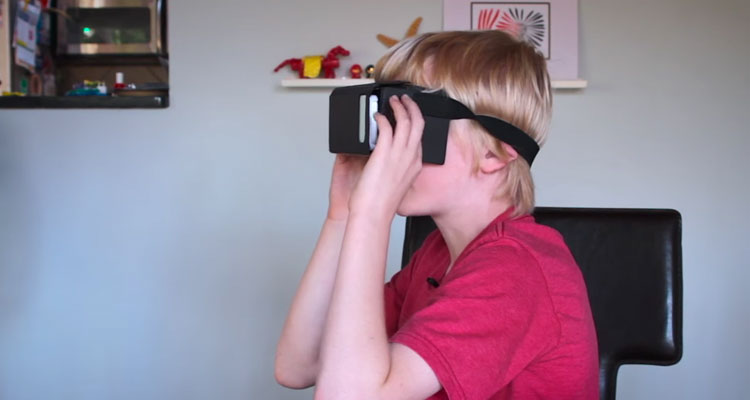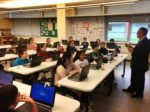You hear a lot nowadays about STEM education (science, technology, engineering, and math). Careers in STEM are hot: The U.S. Bureau of Labor Statistics projects that jobs in STEM fields will increase by up to 30 percent by 2022, a dramatic increase over the average industry growth projection of 11 percent.
But a 2013 study from the U.S. Department of Education’s National Center for Education Statistics found that many college students are dropping out of STEM degree programs despite the dramatic career growth in these fields. The study found that 69 percent of students who entered STEM degree programs dropped out, either leaving college permanently or switching to a different major.
Some students cited intense theory and lack of practical application as a reason for leaving the fields. To counteract this problem, some developers have turned to virtual reality (VR) as a possible way to make STEM learning more hands-on, exciting, and practical.
How Virtual Reality Benefits STEM Education
According to a 2013 report, “Augmented and Mixed Reality: Systems and Application,” virtual reality can be used with STEM subjects in hundreds of ways—the list is nearly endless. VR can help students, even students much younger than college-aged, see the practical side of STEM. It might even plant seeds of curiosity that could one day lead to higher education and even a career in a STEM field.
In one example, Teasley Middle School in Georgia recently tested the zSpace virtual reality STEM education system. Science Department Chair Leah Bleisath said VR allowed students to embrace STEM with confidence and excitement. “It gets them excited about school, and increases their chances of going to the next level.”
In Indiana, an educational nonprofit, La Plaza, recently hosted a virtual reality STEM workshop for local high school students. It allowed them to practice engineering skills by building virtual reality racetracks with help from the staff at the Advanced Visualization Laboratory at Indiana University. The goal of the workshop, one of several held by the organization in support of STEM education, was to encourage the boys to pursue a career in STEM.
As the demand for STEM graduates increases, it seems likely more schools will be adding virtual reality to their curricula in the future.
Making Virtual Reality Obtainable for Students
The virtual reality market is still in its early stages. Many existing VR apps are designed for entertainment, but VR’s potential for education is huge and largely untapped.
How exactly does virtual reality work? In general, a VR headset shows you an image, often with 3D technology—and, as soon as you move your head, it modifies the image to make it seem as if you’re really there. While advanced virtual reality systems (headsets and software/players) can cost hundreds of dollars, there are a few virtual reality systems on the market today that cost less than $25 per unit, making the technology accessible to students. Google Cardboard is the most advanced of the inexpensive VR systems and most VR apps are compatible with it. Another example, the VR Cardboard Kit V2.0 from I Am Cardboard®, has slightly fewer features but provides a similar experience and costs less than $20 per unit. Both work with smartphones.
A few companies, including ZSpace, have created specialized VR systems for the education market that help children complete STEM tasks in a hands-on environment. While more expensive than Google Cardboard, ZSpace is designed with collaboration in mind and allows students to work together to complete STEM projects.
Educational VR STEM Apps for Kids
Here’s a small sampling of virtual reality apps with educational value. They allow students to experience STEM fields in a hands-on way using the Google Cardboard system.
- VR Jurassic Land: VR Jurassic Land transports students back into the time of the dinosaurs. Students can learn about the paleontology first-hand in this virtual, realistic world.
- Maze Cardboard: Spatial awareness is huge for developing STEM skills. This complicated maze tests a student’s logic, as well as path-finding, programming, and memory skills.
- View-Master Space: Space is the final frontier, but you don’t have to be an astronaut to explore space any longer. In View-Master Space, students can learn about astronomy in 3D virtual reality.
- Chemistry VR: Students interested in chemistry can use the Chemistry VR to experience a simulated lab environment in the convenience and safety of their own homes.
- The Brain App: Students can learn all about the brain and how it works in this virtual reality app.
- Earthquake Rebuild: Still in development, Earthquake Rebuild is the most educational VR app to date. In it, students use math, engineering, science, and other technologies to rebuild a 3D town after an earthquake. Fully immersive, the app is designed to encourage students to engage with STEM topics in a hands-on environment.
While the educational VR apps available on the market today are narrow in focus, it’s likely that in the future there will be hundreds of VR STEM options available for both home and classroom use. What worlds will you be able to explore with the help of a VR headset?




































